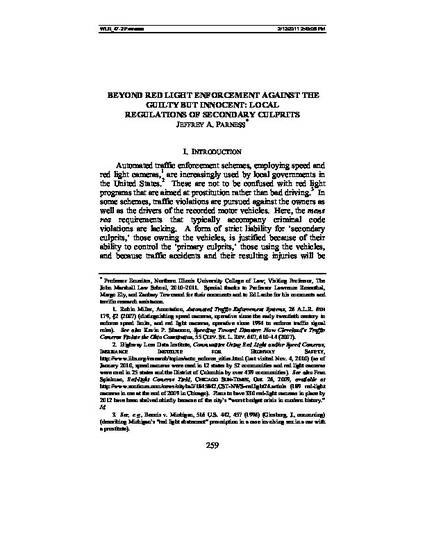
Automated traffic enforcement schemes, employing speed and red light cameras, are increasingly used by local governments in the United States. In some schemes, traffic violations are pursued against the owners as well as the drivers of the recorded motor vehicles. Here, the mens requirements that typically accompany criminal code violations are often lacking. A form of strict liability for secondary culprits is justified because of their ability to control the primary culprits using the vehicles and because traffic accidents will be reduced. While likely to continue to anger many citizens, the surge of automated traffic enforcement schemes will also likely continue since significant deterrence of vehicle violations may follow and because significant additional revenue for local governments will follow. Many violations charged through automated schemes will be processed administratively, that is outside the judicial article courts, freeing trial court judges to handle the pressing business of civil and criminal cases and freeing prosecutors to focus on more serious offenses. Increasing numbers of vehicle owners will likely be punished for the driving of others whose bad acts were never aided, and may even have been expressly banned. There are limits to local governmental regulation of traffic violations involving secondary culprits. Besides public outcry, there are state and federal government preemption's as well as constitutional interests. The constitutional bars include property owner interests in equal protection, non-excessive fines, and due process. Notwithstanding these limits, there is much room for expanding automated traffic enforcement schemes aimed at secondary culprits. Judicial precedents suggest as well there can be expansions of non-automated traffic enforcement schemes, as well as non-traffic enforcement schemes, aimed at property owners as secondary culprits. Such non-traffic schemes today involve trash, booze, tobacco, drugs and adult entertainment. This paper will first review contemporary local regulations of secondary culprits through automated traffic enforcement schemes. It will then examine the limits on such regulations, focusing on the schemes in Knoxville, Cleveland and Chicago. Finally, it will explore potential new local governmental regulations of property owners as secondary culprits in and outside of traffic, and with and without automated enforcement.